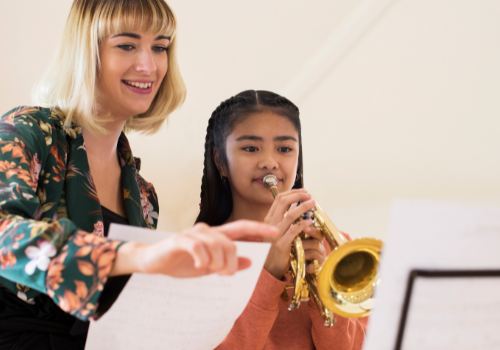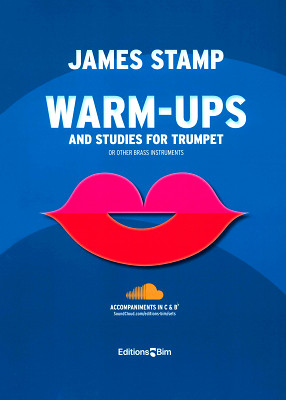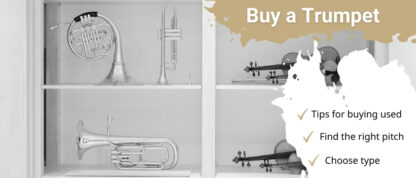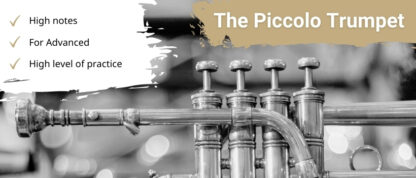Learning how to play a trumpet isn’t that hard and it’s a lot of fun. In addition, you can play so many cool pieces from pop, jazz and classical music, as the instrument is extremely versatile. We are here to help and advise you through the steps. Let’s go!
Posture when playing the trumpet
If you want to be able to play relaxed for a long time, you should establish some basic habits from the beginning. Firstly, you should adopt a relaxed but straight posture. Your legs are shoulder-width apart, your back is straight, your shoulders are relaxed and your neck is also straight. Raise your arms at an angle of about 45 degrees (under your armpits) so that the trumpet is pointing away from you almost horizontally. There is about a 90 degree angle between the upper and lower arm. A good indicator of whether or not you are holding the trumpet correctly is the position of your neck: It should neither be bent forward nor arched backwards.
Fingering on the trumpet

Hold the instrument with your left hand in a relaxed position. The finger hooks directly in front of and behind the valves are held by the thumb and middle finger, which lie in the ring. You can place your index finger loosely between the valves.
The valves are pressed with the right hand – starting with the first valve with the index finger to the third valve, which is operated by the ring finger. The little finger rests in the upper finger hook behind the valves. If the instrument has a fourth valve, like the piccolo trumpet, this is of course pressed by the little finger.
Learning how to play a trumpet yourself is easy – become a professional with 4 tricks
For all of you who want to learn how to play a trumpet at home and don’t quite know how to elicit a clean sound from this great instrument, there are some tips for beginners that you can use to influence your breathing, your technique when blowing into the instrument itself and your tone control. If you internalise these techniques and practice diligently, you will have great success playing the trumpet in the long run.
1. Practice the right breathing for playing the trumpet
Anyone who wants to learn and master the trumpet needs a large lung volume to create the steady flow of air that tone production in the instrument demands of the player. It helps to get your breathing going a little before playing. For example, you can take a deep breath and then very slowly release a small but steady stream of air. Try to pace yourself for as long as possible and practise releasing air for a little longer each day. Use this as a guide to how long you can hold your breath. You should also be able to release air with a “Fff” while holding it.
Another exercise focuses more on the strength of your support. You control the breath through the diaphragm, which is located just below your chest. Now imagine you want to blow out a candle. Inhale and blow out the air with great pressure. Be careful not to inflate your cheeks, but generate the pressure through your diaphragm muscles alone. Practice the same thing while saying “T” as you blow.
2. Practising the buzzing on the trumpet
Before you try the embouchure on the trumpet, it is helpful to practise buzzing. This refers to the vibration of the lips that is needed to elicit a sound from the instrument. You know the phenomenon on a larger scale when your lips are loosely closed and you exhale through your mouth, making a sound like a snorting horse. When you do this, your lips vibrate and open and close rapidly one after the other to give space to the pressure of the air. This is the effect we are looking for when learning the trumpet, only it has to be much more controlled and smaller to work on the small cup mouthpiece. So we want really only the red part of the lips to vibrate and for this purpose we have to build up and strengthen the lip muscles.
The best way to practise humming is to press your lips together, press your tongue against your lower incisors from behind and then send air through. Keep in mind that the entire mouth area remains tense. The vibration now takes place only in the middle part of the lips. In the beginning you will have to practise a few times before the lips actually start to vibrate. If you can’t get any air out at all, try loosening your mouth a bit, because many budding trumpet players get tense at the beginning. The more often you do this exercise dry, the more you will notice that you can play with the air pressure and that – even without a mouthpiece or trumpet – you can change the sound of the air stream.
3. Trumpet embouchure
The first thing is to find the right position on the mouthpiece. Take it off the instrument and place it on the loosely closed lips. It should be placed exactly in the centre of the mouth.but rather place it so that the edges of the mouthpiece are flush with the lighter area around the lips. The red of the lips is needed in the bowl to create the vibration there.
Now you can try buzzing the mouthpiece. If you now vary the air pressure via the tongue position, you will already notice that different tones can be developed. The tongue is crucial for being able to regulate the tones correctly. The higher you raise it at constant air pressure, the higher the tones will be. This is because the air has to flow through a smaller gap and therefore comes in with higher pressure. If you want to be able to play cleanly high, you have to learn and perfect this technique, but what you need most of all is daily practice. So don’t be put off if it doesn’t work perfectly at first.
4. How to togue on a trumpet?
In trumpet playing, the tongue thrust is the technique that you have already learned intuitively during the embouchure. It is about minimally “pushing” or controlling the air with the tip of the tongue. In this way, individual notes can be well distinguished from one another. However, “push” is perhaps not the right term for what actually happens, because you actually hold back the air with the tongue until you have built up the right air pressure, and then let the tongue snap back in a very small movement and release the air. Nevertheless, the term “tongue thrust” has become established and the image certainly helps to understand when learning to play the trumpet that the air has to be set in motion in order to elicit notes from the trumpet.
Playing the first notes on the trumpet
Unlike other wind instruments, whose different tones are regulated more by the tone holes, learning to play the trumpet depends mainly on the blowing technique. Nevertheless, most notes are of course connected with the pressing of one or more valves. In the notes for the trumpet, therefore, the valves that have to be pressed are always written at the beginning. A 0 above the note means that no valve is pressed. 1, 2 and 3 correspond to the order of the valves on the instrument as seen from you. If several valves have to be pressed, they are listed one above the other above the note in question. In time you will know the combinations by heart and will no longer need any auxiliary markings, but in the beginning it is worth having a fingering chart and a work on the first music theory facts at hand.
Free sheet music for the trumpet
As with almost all instruments, there are many places online to get free sheet music of common pieces. For example, the collection of trumpet pieces on the Pinterest page Notendownload is suitable for both beginners and more advanced trumpet players. On Youtube, there are also extensive practice pieces with piano accompaniment on the channels Play-Along for Trumpet and anvesir. If you are looking for specific sheet music for learning the trumpet or if you need complete scores, the best place to look is the following online shops specialising in learning material:
Trompete online lernen

On the webpage of trumpetheadquarters, the certified music teacher Estela Aragon, who specialises in the trumpet, offers a trumpet course especially for beginners, which accompanies all the first steps from the correct grip, to the attack, to the first pieces. The course costs $ 17.60 a month and follows a pedagogical curriculum. Each lesson consists of a part with practical questions, i.e. how to play something, the second part is dedicated to the music-theoretical background in each case. All materials can be saved and printed out, but of course access is unlimited. Learning to play the trumpet is made very easy here, ideal for beginners – and of course cheaper than with a private teacher.
An alternative is to find a private teacher who also offers online lessons via the Superprof platform. This is practical in that the teacher can adapt the lessons specifically to your level of knowledge and, if the technical aids (good camera and microphone) are at hand, can also improve you in a more targeted way and remind you directly of little things that you don’t even notice yourself. Learning the trumpet with direct feedback can be a lot of fun and is very effective.
FAQ: Learning the trumpet is not difficult!
Learning to play the trumpet is certainly not as intuitively accessible as learning to play other wind instruments that are regulated entirely by tone holes or keys. The difficulty lies in the fact that the ear must be trained to a greater extent so that the notes come cleanly. Another special feature is that the lips are used more directly than on a woodwind instrument, for example. Nevertheless, even schoolchildren can quickly find an approach to the instrument, which is why the level of difficulty is no higher than with other instruments.
You can learn the trumpet in brass classes, with a private teacher on site or online. There is are online schools for beginners and also some teachers who give lessons online. How you learn best depends on you. If you are self-taught, you must of course have a high degree of discipline to keep at it. Because regularity is the be-all and end-all of learning an instrument.
It usually only takes a few months to understand the instrument, to elicit sounds from it and to play your first little songs. After a year, you should already have a good command of some things. However, to become a truly virtuoso musician, you should expect 5-10 years. Learning and practising never stops and there are many areas of music that can be acquired.















